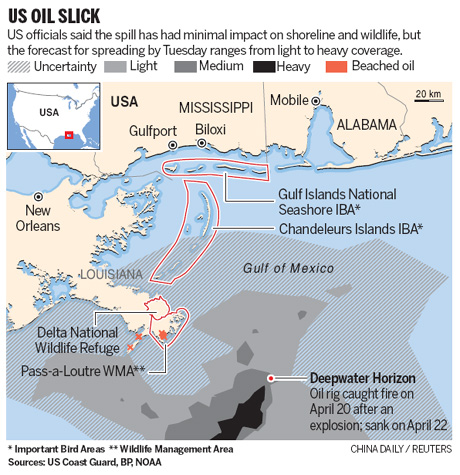InfoGraphic
Spill outlook bleak for US coast
By JEFFREY COLLINS (China Daily)
Updated: 2010-05-17 11:22
 |
Large Medium Small |

BP battles to contain gushing leaks fouling the Gulf of Mexico
ROBERT, Louisiana- Scientists have found huge plumes of oil lurking under the surface of the water in the Gulf of Mexico, as BP hit a snag in its latest effort to slow down the oil blasting out of a broken undersea pipe.
At least 790,000 liters (210,000 gallons) of oil has gushed into the Gulf of Mexico since an oil rig exploded April 20 and sank two days later. Eleven people were killed in the blast.
BP PLC is trying to use a 1.5-km-long pipe to capture the oil flowing into the Gulf, but engineers on Saturday failed to connect two pieces of equipment below the water's surface. BP PLC chief operating officer Doug Suttles said one piece of equipment, called the framework, had to be brought to the surface and adjusted to fit with the long tube that connects to a tanker above.
The framework holds a pipe and stopper, and engineers piloting submarine robots will try to use it to plug the massive leak and send the crude through the pipe to the surface.
"The frame shifted, so they were unable to make that connection," said Suttles, who said he believes the adjustments will work.
If the tube works, it would be the first time the company has been able to capture any of the oil before it fouls the Gulf waters.
Researchers from the National Institute for Undersea Science and Technology, meanwhile, say they have detected large oil plumes from just beneath the surface of the sea to more than 1,200 meters (4,000 feet) deep.
Three or four large plumes have been found, at least one that is 16 kilometers (10 miles) long and 1.6 kilometers wide, said Samantha Joye, a marine science professor at the University of Georgia.
Researchers Vernon Asper and Arne Dierks said in Web posts that the plumes were "perhaps due to the deep injection of dispersants which BP has stated that they are conducting."
These researchers were also testing the effects of large amounts of subsea oil on oxygen levels in the water. The oil can deplete oxygen in the water, harming plankton and other tiny creatures that serve as food for a wide variety of sea critters.
Oxygen levels in some areas have dropped 30 percent, and should continue to drop, Joye said.
"It could take years, possibly decades, for the system to recover from an infusion of this quantity of oil and gas," Joye said. "We've never seen anything like this before. It's impossible to fathom the impact."
Joye's lab was waiting for the research boat to return so a team of scientists can test about 75 water samples and 100 sediment samples gathered during the voyage. Researchers plan to go back out in about a month and sample the same areas to see if oil and oxygen levels have worsened.
One expert said BP's latest idea seems to have the best chance for success so far. Inserting a pipe into the oil gusher would be easy at the surface, said Ed Overton, a LSU professor of environmental studies. But using robots in deep water with oil rushing out of the pipe makes things much more difficult.
"It's something like threading the eye of a needle. But that can be tough to do up here. And you can imagine how hard it would be to do it down there with a robot," Overton said.
The tube could capture more than three-quarters of the leak. BP also must contend with a smaller leak that's farther away.
A week ago, the company tried to put a massive box over the main leak, but icelike crystals formed and BP scrapped that plan.
BP is also drilling a relief well that is considered the permanent solution to stopping the leak. It's about halfway done and still months away from being completed. The company also is still considering using a smaller containment dome known as a "top hat," as well as a "junk shot," in which golf balls and rubber would be inserted to try to clog the leak.
This unprecedented use of chemical dispersants underwater and the depth of the leak have created many unknowns regarding environmental impact, and researchers hurriedly worked to chart its effects.
Federal regulators on Friday approved the underwater use of the chemicals, which act like a detergent to break the oil into small globules and allow it to disperse more quickly into the water or air before it comes ashore.
"We didn't cross this threshold lightly," Coast Guard Rear Admiral Mary Landry said. "This is a tool that will be analyzed and monitored."
As crews worked to limit the environmental hazards, Secretary of Homeland Security Janet Napolitano pressured BP to make clear whether the company would limit how much it will pay for clean up and compensation to those hurt by the spill.
Associated Press



